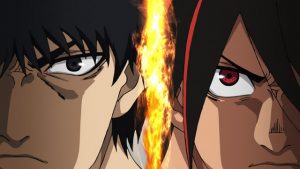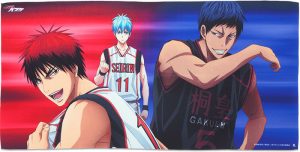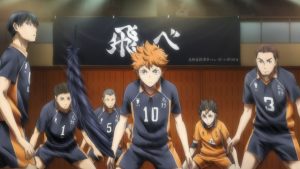
Sports anime titles are notably hit or miss with international audiences for reasons that qualify as its own article but are very popular in its native Japan. For now, we wish to explore how this genre diversifies in many unique ways. Some take place in a school setting, others under professional conditions, and others that go in a very crazy and some would argue, creative direction. So, what are some of the sports anime that fit under these categories?
School
A good percentage of sports anime are largely featured in a school setting. This applies to Prince of Tennis, Hinomaruzumou, Slam Dunk, and All Out!! So, what’s the idea behind this? In schools across Japan, students are strongly encouraged to participate in sports. Though this may not be present in the consciousness of non-Japanese viewers, but the reason why participating in sports is such a big deal in the school system is because it teaches members how to get ready for the real world. Through all the anime we just listed, they actually do a great job of showing how members are supposed to interact with their senpai, kouhai, captain and coach.
When audiences view such anime, it teaches you how to manage such relationships in society. Though this isn’t exactly portrayed in the anime we listed, putting what club you were in back in secondary school on your resume is actually big in Japan. If you participated in team sports, it gives the company a better idea that you can be a team member to them as well. When you take into account Japanese society’s group-oriented mentality, such sports titles are relatable to its native audience. In let’s say American society, individualism is encouraged and sports aren’t exactly for everyone, which is why the genre doesn’t resonate with some non-Japanese viewers.
Educational
A lot of sports anime do a great job of educating their viewers behind the sport it portrays. This quality is most emphasized in the boxing series, Hajime no Ippo. It shows audiences how there are various styles suited to a character’s build such as Ippo’s peek-a-boo and close quarters power oriented style for his stockier build, and how it contrasts to the taller Miyata’s stick and move style which relies on speed. Depending on the match, audiences can see how Ippo prepares and what parts of his body he has to train in order to get ready. You see how certain exercises create muscle memory and how it contributes to his performance, and it’s what real fighters do.
One unorthodox sports anime that excellently fits well into how it excellently educates its audience is the street racing hit, Initial D. Largely narrated through the supporting character Ryousuke, audiences can learn how drifts work and how a car needs to be modified in order to perform on certain courses. You learn how street racing can foster certain unconventional techniques and thinking as opposed to racing on an actual track. This is largely demonstrated when Ryousuke races Kyouichi, who has a professional background. Due to the risk of possible oncoming traffic, Kyouichi exhibits a hint of hesitation when turning right (remember that Japanese drive on the left side), and it affects his performance. Ryousuke deduces this and exploits it to get the W.
Professional/Life Story
Some anime tend to tell a full story of one’s career in one particular sport from beginning to end. This originated with Kyojin no Hoshi, of how Hoshi starts his career in little league baseball, to competing in high school, and finally as a pro. In the eighties and its 2018 remake, this story applied to soccer with Captain Tsubasa. In recent years, we have also seen this with Free! where the characters start as children, and you see how they advance to a more competitive level as the series progresses. While all three anime cover different sports, they do have very common qualities with how you see the main characters start off as children, and they stay dedicated to their craft to the pros. However, with Kyojin no Hoshi as an older title, the training methods portrayed in that series (especially when Hoshi was a child) now qualify as a visit from CPS by today’s standards. With modern titles like Free!, the cast trains hard but not to a point where you can consider it child abuse/labor.
Other
On the surface, Free! seems like a yaoi series with how it gender swaps the studio’s (meaning Kyoto Animation) typical female oriented titles with boys. You see the team together in skimpy swimsuits looking like they’re intimate, but it’s not like that. However, if there is one anime that has been known to go in that direction in a more suggestive sense, then that’s what Yuri!! on Ice is for. Yuri!! on Ice does a great job of portraying same sex relationships in a very natural sense and not just for novelty’s sake. You see how significant a relationship between a coach and athlete is very beneficial to development and success, and sometimes, love can be born out of it.
Final Thoughts

Then there’s the sports anime that tend to be over the top, and this was popularized by Prince of Tennis by metaphorically portraying the characters’ abilities as typical Shounen manga attacks (look up Tezuka destroys the dinosaurs on YouTube). It has been criticized even by Konomi, the original creator himself. In addition to Prince of Tennis, Kuroko no Basuke has also taken this notion in application to basketball where characters have strange auras. If any anime series popularized this aspect to sports, it has to be Masami Kurumada’s Ring ni Kakero, a boxing manga that takes the imagination to levels that likely was the result of some crazy drugs. Either way, sports may not be appealing to non-Japanese on a surface level, but once you see past that, they all share universal and relatable qualities.
Recommended Post
Top 5 Sports Anime [Updated Best Recommendations]
Recommended Post
Top 10 Sports Anime for Girls [Best Recommendations]
Recommended Post
Top 10 Made-up Sports in Anime [Best Recommendations]
Recommended Post
There’s Never Been a Better Time for Sports Anime!
Recommended Post






